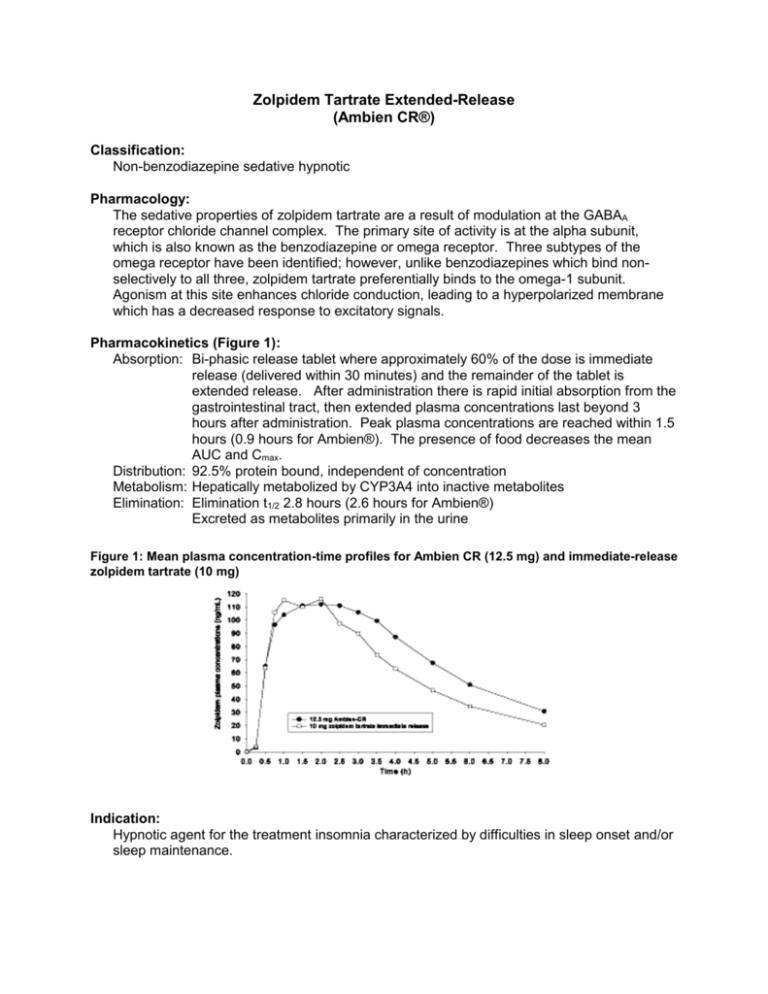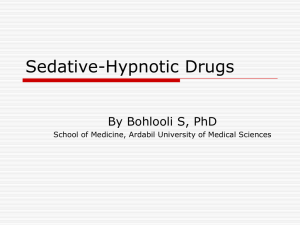Zolpidem Tartrate Extended
advertisement

Zolpidem Tartrate Extended-Release (Ambien CR®) Classification: Non-benzodiazepine sedative hypnotic Pharmacology: The sedative properties of zolpidem tartrate are a result of modulation at the GABAA receptor chloride channel complex. The primary site of activity is at the alpha subunit, which is also known as the benzodiazepine or omega receptor. Three subtypes of the omega receptor have been identified; however, unlike benzodiazepines which bind nonselectively to all three, zolpidem tartrate preferentially binds to the omega-1 subunit. Agonism at this site enhances chloride conduction, leading to a hyperpolarized membrane which has a decreased response to excitatory signals. Pharmacokinetics (Figure 1): Absorption: Bi-phasic release tablet where approximately 60% of the dose is immediate release (delivered within 30 minutes) and the remainder of the tablet is extended release. After administration there is rapid initial absorption from the gastrointestinal tract, then extended plasma concentrations last beyond 3 hours after administration. Peak plasma concentrations are reached within 1.5 hours (0.9 hours for Ambien®). The presence of food decreases the mean AUC and Cmax. Distribution: 92.5% protein bound, independent of concentration Metabolism: Hepatically metabolized by CYP3A4 into inactive metabolites Elimination: Elimination t1/2 2.8 hours (2.6 hours for Ambien®) Excreted as metabolites primarily in the urine Figure 1: Mean plasma concentration-time profiles for Ambien CR (12.5 mg) and immediate-release zolpidem tartrate (10 mg) Indication: Hypnotic agent for the treatment insomnia characterized by difficulties in sleep onset and/or sleep maintenance. Dosage and Administration: Adults: 12.5mg immediately before bedtime, do not exceed 12.5mg/day Elderly patients: 6.25mg immediately before bedtime Hepatic impairment: 6.25mg immediately before bedtime Tablets should be swallowed whole, not crushed, divided, or chewed. Administration of zolpidem tartrate with or immediately following a meal is not recommended. Contraindications: Known hypersensitivity to this product or any ingredient in this product: reactions such as angioedema or anaphylaxis. Precautions: Pregnancy category C Worsening of depression Withdrawal effects with rapid dose reduction or discontinuation Respiratory diseases, such as COPD or sleep apnea Significant hepatic impairment Elderly/debilitated patients; dosage adjustment required Symptoms of depression or suicidal ideation Concomitant use of CNS depressants Concomitant use of potent 3A4 inhibitors Avoid driving/operating heavy machinery following administration Activities following administration should be limited to those necessary to prepare for bed Interactions: Zolpidem tartrate is a substrate of 3A4 (major), 1A2 (minor), 2C9 (minor), 2C19 (minor), and 2E1 (minor). Inhibitors of CYP3A4 (i.e. ciprofloxacin, clarithromycin, doxycycline, erythromycin, fluoxetine, fluvoxamine, isoniazid, protease inhibitors, verapamil) can significantly increase the levels and effects of zolpidem. Likewise, inducers of CYP3A4 (i.e. carbamazepine, phenobarbital, phenytoin) can decrease the levels and effects of zolpidem. Concomitant use of ethanol or other CNS depressants can increase the risk of sedation. Adverse Reactions: Sleep related behaviors such as sleep-driving, sleep-walking, eating while sleeping, or making phone calls while sleeping may possibly be experienced while taking zolpidem tartrate. Decreased inhibition, visual and auditory hallucinations, changes in behavior, amnesia, anxiety, and other neuropsychiatric symptoms may occur unpredictably. Other side effects include headache, next day somnolence, and dizziness. Cost comparison of non-benzodiazepine (Z-drug) sedative-hypnotics: Generic Name Brand Name Strength Unit Price eszopiclone Lunesta® 2mg $4.09 zaleplon Sonata® 10mg $3.10 zolpidem tartrate Ambien CR® 12.5mg $3.68 zolpidem tartrate Ambien® 10mg $0.06 -Usual dosage strength and unit dose product (when available) used for cost comparison between products -Shaded rows indicate non-formulary status Monitoring Parameters: No standard monitoring is required in the labeling Monitoring requirements would be the same as for Ambien®, which would include a pregnancy test as clinically indicated Product Identification: Dose Color 6.25mg Pink 12.5mg Blue Shape Round, bi-convex Round, bi-convex Imprint A~ A~ Efficacy: Zolpidem extended-release (CR) has been examined for the treatment of primary insomnia in both short-term and long-term studies in adults and geriatric patients. One 3-week study examined the short-term efficacy and safety of zolpidem CR in patients with primary insomnia.2 A total of 212 patients were randomized to nightly treatment with zolpidem CR 12.5mg or placebo. The study included a 2 night single-blind placebo run-in polysomnographic (PSG) screening phase to assess baseline sleep parameters, a 21-night double-blind, randomized, treatment phase, and a 2 night single-blind placebo discontinuation phase. In addition to the PSG assessments, patients also completed evening and morning sleep questionnaires. Results showed zolpidem CR improved sleep maintenance by significantly reducing PSG wake time after sleep onset (WASO) during the first 6 hours of sleep (mean improvement over placebo of approximately 23 minutes on nights 1 & 2 and 16 minutes on nights 15 &16) as well as the total number of awakenings (decreased from approximately 5 at baseline to 2 with active treatment). Zolpidem CR also reduced latency to persistent sleep (7-10 minutes over placebo) and increased sleep efficiency during treatment. Patient self-report measures were also improved with active treatment compared to placebo. There was no evidence of next day residual effects as measured by psychometric testing (digit symbol substitution test and Rey auditory verbal learning test) within 30 minutes of awakening. Efficacy and safety of zolpidem CR was also examined in elderly patients with primary insomnia.3 A total of 205 elderly patients with primary insomnia were randomized to 3 weeks of nightly treatment with zolpidem CR 6.25mg or placebo. Methods were similar to the above study with the exception of the lower zolpidem dose. Zolpidem CR significantly reduced PSG WASO during the first 6 hours compared to placebo. PSG latency to persistent sleep and total sleep time were both significantly improved with zolpidem CR compared to placebo. Patient self-report measures were significantly better with active treatment. Adverse events were comparable between the two groups. The long-term efficacy and safety of zolpidem CR has also been evaluated in adults with primary insomnia.4 The study was a multicenter 25-week randomized, double-blind, placebo-controlled outpatient trial. Zolpidem CR 12.5mg (n=669) or placebo (n=349) was self-administered at least 3 nights per week up to a maximum of 7 nights per week. Zolpidem CR was significantly superior to placebo at every time point for patient global impression of improvement, clinical global impression of improvement, total sleep time, WASO, quality of sleep, sleep onset latency, and number of awakenings. Morning sleepiness and ability to concentrate was improved at all time points with zolpidem CR compared to placebo. The most common side effects reported were headache, anxiety, and somnolence. There are currently no comparative efficacy studies between zolpidem CR and other Zdrugs including zolpidem immediate release (IR) in patients with insomnia. One Phase IIIb study does compare zolpidem IR and zolpidem CR to placebo; however, this study was not designed to compare the two active treatments.5-6 The study was a double-blind, randomized, placebo-controlled, three-way crossover study examining zolpidem CR 12.5mg and zolpidem IR 10mg as compared to placebo in 113 adult patients with insomnia. The study duration was 24-26 days and consisted of 2 treatment phases. The first phase was the screening phase where patients received 2 nights of PSG screening in a sleep laboratory with single-blind placebo followed by a 5 day washout period. The second phase was the double-blind treatment phase which consisted of 3 periods. Each period consisted of 2 nights of PSG in a sleep lab with double-blind study treatment separated by a 5 day washout. The primary efficacy measure was the mean wake time after sleep onset (WASO; 1 to 6 hours) measured by PSG. Secondary measures included sleep efficiency, latency to persistent sleep, WASO 1 to 8 hours, WASO during the first 3 hours, WASO during the middle hours 4 to 6, and WASO during the last hours 7 to 8, and number of nocturnal awakenings (Table 1). Subjective patient-rated measures were all superior for active treatment vs. placebo. Treatment related adverse events (Table 2) were similar between active treatment groups (25.9% in the zolpidem CR 12.5mg group and 24.1% in the zolpidem IR 10mg group). One patient in the zolpidem CR 12.5mg group withdrew from the study after the 2nd dose due to confusion, ataxia, and somnolence resulting in a fall. This adverse event was determined to be due to the study medication. Table 1: Results of Primary and Secondary PSG Outcome Measures ZOLPIDEM IR ZOLPIDEM CR OUTCOME MEASURE 10MG 12.5MG WASO (hours 1 to 6) 19 min* 23 min* Mean decrease compared to placebo WASO (hours 1 to 8) 20 min* 25 min* Mean decrease compared to placebo WASO (hours 1 to 3) 8 min* 8 min* Mean decrease compared to placebo WASO (hours 4 to 6) 11 min* 14 min* Mean decrease compared to placebo WASO (hours 7 to 8) 1 min 2 min Mean decrease compared to placebo Sleep efficiency 6.4%* 6.5%* % improvement compared to placebo Latency to persistent sleep 12 min* 7 min** Mean decrease compared to placebo Number of nocturnal awakenings 1.2 fewer* 1.8 fewer*** Decrease in awakenings compared to placebo -All values are rounded to the nearest minute where applicable -Shaded row indicates primary outcome measure *p<0.0001 vs. placebo **p<0.0026 vs. placebo ***p<0.0003 vs. placebo Table 2: Reported Treatment Emergent Adverse Events (TEAEs) >3% PLACEBO TEAE ZOLPIDEM IR 10MG (N=112) ZOLPIDEM CR 12.5MG (N=108) (N=111) Somnolence 1.8% 5.6% 6.3% Headache 5.4% 5.6% 5.4% Nausea 0.0% 0.9% 4.5% Adapted from references 5 and 6 Conclusions: The efficacy and safety of zolpidem CR for the treatment of insomnia in patients with sleep onset insomnia and sleep maintenance difficulties has been established in controlled trials. Treatment related adverse events and side effects appear to be similar to what has been reported with zolpidem IR. The place in therapy of zolpidem CR compared to the other Zdrugs is less well established. Only one Phase IIIb study is available which compares zolpidem IR and zolpidem CR to placebo; however, the study was not designed to compare the two active treatments. Both zolpidem IR and CR faired better than placebo on all objective PSG primary and secondary outcome measures except for WASO for hours 7 to 8 in which neither of the active treatments reached statistical significance vs. placebo. Zolpidem IR 10mg is available generically at a cost that is 61-times less expensive than Zolpidem CR 12.5mg. Based on the available studies to date, it does not appear to be a reasonable strategy to use zolpidem CR without an initial trial of zolpidem IR. Based on the available literature, some patients treated with zolpidem IR may benefit not only from sleep onset insomnia, but possibly sleep maintenance insomnia as well. Zolpidem IR, however, is not currently FDA approved for sleep maintenance insomnia. Recommendation: Ambien CR® is not recommended for addition to the formulary. References: 1. Ambien CR® (zolpidem tartrate extended-release tablet) [package insert]. Bridgewater, NJ: Sanofi-Aventis U.S. LLC; January 2008. 2. Roth T, Soubrane C, Titeux L, et al. Efficacy and safety of zolpidem-MR: A doubleblind, placebo-controlled study in adults with primary insomnia. Sleep Medicine 2006;7:397-406. 3. Walsh JK, Soubrane C, Roth T. Efficacy and safety of zolpidem extended release in elderly primary insomnia patients. Am J Geriatr Psychiatry 2008;16(1):44-57. 4. Krystal AD, ERman M, Zammit GK, et al. Long-term efficacy and safety of zolpidem extended-release 12.5mg, administered 3 to 7 nights per week for 24 weeks, in patients with chronic primary insomnia: a 6-month, randomized, double-blind, placebo-controlled, parallel-group, multicenter study. Sleep 2008;31(1):79-90. 5. Data on File. Sanofi-Aventis. 6. Evaluation of the hypnotic properties of zolpidem-MR 12.5mg and zolpidem 10mg. Available at: www.clinicalstudyresults.org. Accessed April 23, 2008. Prepared by: Lisa M. Mican, Pharm.D., BCPP Assistant Director of Pharmacy Clinical Psychopharmacologist Austin State Hospital May 2008 Angela Bird Pharm.D. Candidate 2009 Pharmacy Volunteer Austin State Hospital





